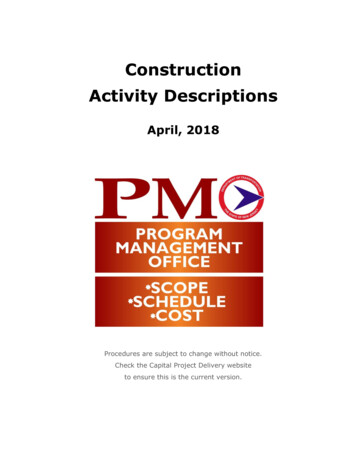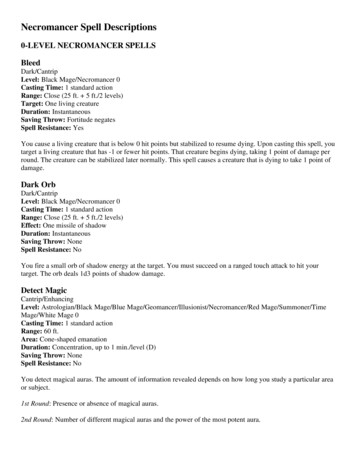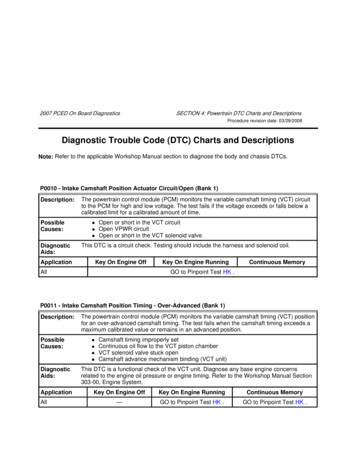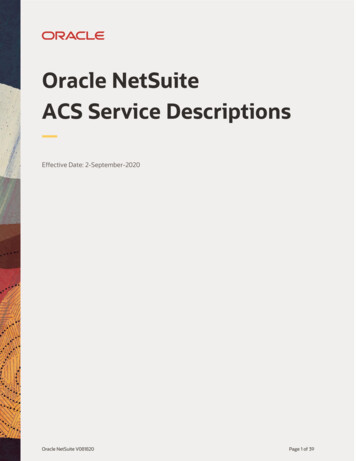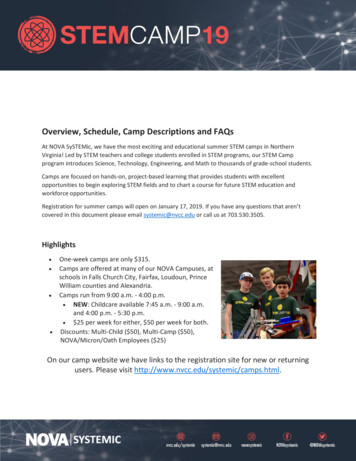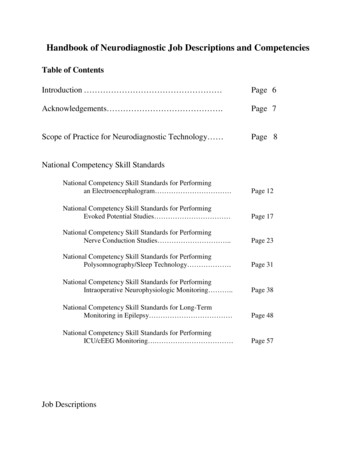
Transcription
Handbook of Neurodiagnostic Job Descriptions and CompetenciesTable of ContentsIntroduction Page 6Acknowledgements .Page 7Scope of Practice for Neurodiagnostic Technology Page 8National Competency Skill StandardsNational Competency Skill Standards for Performingan Electroencephalogram Page 12National Competency Skill Standards for PerformingEvoked Potential Studies Page 17National Competency Skill Standards for PerformingNerve Conduction Studies .Page 23National Competency Skill Standards for PerformingPolysomnography/Sleep Technology .Page 31National Competency Skill Standards for PerformingIntraoperative Neurophysiologic Monitoring .Page 38National Competency Skill Standards for Long-TermMonitoring in Epilepsy Page 48National Competency Skill Standards for PerformingICU/cEEG Monitoring . Page 57Job Descriptions
Neurodiagnostic Assistant Page 66Electroencephalographic (EEG) Technologist I .Page 68Electroencephalographic (EEG) Technologist II .Page 71Evoked Potential (EP) Technologist I .Page 73Evoked Potential (EP) Technologist II .Page 76Nerve Conduction Studies (NCS) Technologist I .Page 78Nerve Conduction Studies (NCS) Technologist II .Page 81Polysomnographic (PSG)/Sleep Technologist I . Page 84Polysomnographic (PSG)/Sleep Technologist II .Page 87Intraoperative Neuromonitoring (IONM) Specialist I .Page 90Intraoperative Neuromonitoring (IONM) Specialist II Page 93Long-Term Monitoring for Epilepsy (LTME) Specialist I .Page 97Long-Term Monitoring for Epilepsy (LTME) Specialist II .Page 100Intensive Care Unit/continuous EEG (ICU/cEEG) Specialist I Page 103Intensive Care Unit/continuous EEG (ICU/cEEG) Specialist II Page 106Neurodiagnostic Technology Clinical Instructor Page 109Neurodiagnostic Technology Program Director . Page 112Neurodiagnostic Clinical Educator . Page 115Neurodiagnostic Supervisor . . . Page 119Neurodiagnostic Director . . . Page 123Competency Checklists
Electroencephalography (EEG) . . Page 128Evoked Potentials (EP) . . .Page 139Nerve Conduction Studies (NCS) . . .Page 151Polysomnography (PSG)/Sleep Technology . Page 163Intraoperative Neuromonitoring (IONM) . .Page 177Long-Term Monitoring for Epilepsy (LTME) . . Page 193Intensive Care Unit/continuous EEG (ICU/cEEG) Monitoring . Page 204
Job Title: Electroencephalographic (EEG) Technologist IIThis Job Description is designed to be used as a guideline in conjunction with the facilitypolicies and procedures.The duties listed in this Job Description guideline are performed under the direction ofadministrative and clinical leadership as defined by facility policies and procedures.The supervision levels in this Job Description guideline refer to technical supervision only.General Summary: The EEG Technologist II has passed examination by the American Boardof Registration of Electroencephalographic and Evoked Potential Technologists, Inc. (ABRET)and proven competence to obtain a credential in electroencephalography (R. EEG T.*). The EEGTechnologist II has a minimum of three years experience in performing electroencephalography.The EEG Technologist II provides findings, results, and a descriptive analysis according tofacility policy and procedures. Strong well developed communication skills are essential for thisposition. The EEG Technologist II performs procedures appropriate to their competence andcredentials held under general technical supervision3.3General technical supervision requires that the EEG procedure is performed under technicalsupervision as detailed in the facility policy and procedure manual.Minimum Requirements: An EEG Technologist II must have all of the following in addition tobeing BLS certified:1. Credential in electroencephalography (R. EEG T.*).2. Three or more years experience in the performance of EEG procedures in a patient careenvironment.3. Well developed PC and Microsoft Windows knowledge.Education:Graduation from a Commission on Accreditation of Allied Health Education Programs(CAAHEP) accredited Electroneurodiagnostic (END) Program, or an Associate’s degreeor higher from an accredited college or university is desired.Reports to: The EEG Technologist II works under general technical supervision3.Administrative and clinical leadership as is defined by facility policy and procedures.Principal Duties and Responsibilities:Detailed competency criteria: National Competency Skill Standards for Performing anElectroencephalogram are published in this Handbook of Neurodiagnostic Job Descriptions andCompetencies on page 12.The EEG Technologist II has an expected level of competence and is able to independentlyperform duties and responsibilities for electroencephalography under general technicalsupervision3; recognizes clinically significant events and follows facility policy and proceduresregarding critical test results**; maintains continuing education requirements of ABRET for
R. EEG T. credential by reviewing literature and attending educational meetings for the latestaccepted practices and electrical safety relevant to equipment and testing; establishes policiesand procedures according to established standards of practice; performs any other related dutiesthat are consistent with patient and technical care for this level; participates in tutoring,demonstrating, and mentoring other team members; provides direct technical supervision1 andindirect technical supervision2 to the EEG Technologist I as required.Physical Skills:1. Frequent walking2. Sitting/standing3. Reaching including above/below shoulder height4. Some kneeling/crawling5. Pulling/pushing 50 pounds6. Carrying 50 poundsPhysical Exposure: Lighting bright and dim, mechanical hazards, hazardous substances,infectious diseases.Physical Ability: Must be good or greater: vision, hearing, manual dexterity, talking and speech,typing. Requires the ability to concentrate for long periods of time under stressful conditions andstill perform properly and effectively.1Direct technical supervision requires that an EEG Technologist II or a physician who performsall technical aspects required for electroencephalography must be physically present at all timesduring the procedure.2Indirect technical supervision requires that an EEG Technologist II or a physician whoperforms all technical aspects required for electroencephalography must be immediatelyavailable to provide assistance and direction throughout the procedure.3General technical supervision requires that the EEG procedure is performed under technicalsupervision as detailed in the facility policy and procedure manual.The EEG Technologist I and EEG Technologist II job descriptions do not supersedegovernmental regulation and/or state licensure laws or affect the interpretation of such laws ifthey so exist.APPENDIX:*The R. EEG T. credential is granted by the American Board of Registration ofElectroencephalographic and Evoked Potential Technologists, Inc. (ABRET). www.abret.org**Critical test results – any values/interpretations where delays in reporting may result in seriousadverse outcomes for patients. MA Coalition for Prevention of Medical df-- Approved by ASET Board of Trustees March 2011 Copyright 2011 by the American Society of Electroneurodiagnostic Technologists, Inc.
Job Title: Intraoperative Neuromonitoring (IONM) Specialist IIThis Job Description is designed to be used as a guideline in conjunction with the facilitypolicies and procedures.The duties listed in this Job Description guideline are performed under the direction ofadministrative and clinical leadership as defined by facility policies and procedures.The supervision levels in this Job Description guideline refer to technical supervision only.General Summary: The Intraoperative Neuromonitoring (IONM) Specialist II is an advancedposition for intraoperative neuromonitoring. An IONM Specialist II has a Certification inNeurophysiologic Intraoperative Monitoring (CNIM*). In addition to IONM Specialist Iresponsibilities, the IONM Specialist II can perform IONM procedures appropriate to theircompetence and credentials held under general technical supervision3, and has provencompetence in the performance of routine single and multi-modality IONM. The IONMSpecialist II provides findings, results, and a descriptive analysis according to facility policy andprocedures. Strong well-developed communication skills are essential for this position.3General technical supervision requires that the intraoperative neuromonitoring procedure isperformed under technical supervision as detailed in the facility policy and procedure manual.Minimum Requirements: An IONM Specialist II must have the following in addition to beingBLS certified:1.2.Certification in Intraoperative Neurophysiologic Monitoring (CNIM*) credential.A minimum of 3 years experience in neurodiagnostics which includes at least 2 years inIONM.(Credentials in neurodiagnostics from other nations may also be considered as fulfillment ofthe registry requirements.)Education:Graduation from a Commission on Accreditation of Allied Health Education Programs(CAAHEP) accredited Electroneurodiagnostic (END) Program, or a Bachelor’s Degreefrom an accredited college or university is desired.Reports to: An Intraoperative Neuromonitoring Specialist II works under general technicalsupervision3. Administrative and clinical leadership as is defined by facility policy andprocedures.
Principal Duties and Responsibilities:Detailed competency criteria: National Competency Skill Standards for Performing IntraoperativeNeurophysiologic Monitoring are published in this Handbook of Neurodiagnostic Job Descriptionsand Competencies on page 38.IONM Specialist II performs all duties and responsibilities, for modality of monitoring requestedfor which competencies and credentials are held under general technical supervision3; provides2direct technical supervision1 and indirect technical supervision to IONM Specialist I asrequired; maintains continuing education requirements of ABRET for CNIM certification byreviewing literature for latest accepted practices and electrical safety relevant to equipment andtesting; and establishes facility policies and procedures.The IONM Specialist II is a valuable member of the intraoperative neurophysiologicalmonitoring team working closely and collaborating with nurses, physicians, and other medicalstaff caring for the patient.Preoperatively:IONM Specialist II reviews planned intraoperative procedure and orders for monitoring todetermine the structures at risk relative to patient history/pre-existing conditions and monitoringrequested; makes needed adjustments in monitoring by communicating with correct personnelwhile maintaining patient confidentiality according to facility policy and procedures;communicates with needed departments to obtain access and scheduling of patient according tofacility policy and procedures; prepares equipment and supplies for required monitoring ofpatient according to facility policy and procedures; identifies correct patient by name, orderingsurgeon, and type of procedure to be performed and communicates the monitoring plan to thepatient/caregivers/family in language consistent with their ability to understand; measures andmarks correct recording and stimulation sites and applies electrodes according to facility policyand procedures.Intraoperatively:IONM Specialist II positions monitoring equipment in the operating room to ensure patientelectrical safety and communicates with team members including anesthesia, surgeon, andnursing staff according to facility policy and procedures; communications directly withanesthesia team and surgeon to enhance monitoring results; discusses with surgeon baselinerecordings according to facility policy and procedures; makes any needed adjustments inmonitoring according to facility policy and procedures; monitors neurophysiologiccentral/peripheral functioning throughout the operative procedure communicating with surgeon,neurophysiologist, anesthesia team, and nursing staff as necessary according to facility policyand procedures; recognizes clinically significant events and follows facility policy andprocedures regarding critical test results**; documents in surgery log throughout the monitoringprocess all relative communications/responses, physiological status, anesthetic adjustments, andchanges in verbal responses according to facility policy and procedures; discontinues monitoringand removes all monitoring and stimulation electrodes checking sites for pre-monitoring statusaccording to facility policy and procedures.
Post-operatively:The IONM Specialist II provides findings, results, and a descriptive analysis according to facilitypolicy and procedure; cleans/disinfects electrodes and equipment according to facility policy andprocedures; restocks equipment and electrode supplies; prints needed documents includingwaveforms, neuromonitoring specialist report, and surgery log to be dictated by interpretingpersonnel according to facility policy and procedures; charges and logs patient according tofacility policy and procedures.Physical Skills;1.2.3.4.5.6.7.Frequent walkingSitting /standingReaching including above/below shoulder heightFrequent kneeling/crawlingPulling and pushing 50 poundsCarrying or pushing 50 poundsFrequent bending /stooping/crouching/twisting and continuous repetitive movementsPhysical Exposure:Lighting bright and dim, mechanical hazards, hazardous substances, infectious diseases,ionizing/non-ionizing radiation, and toleration of temperature ranges 60 to 75 F.Physical Ability: Must be good or greater: vision, hearing, manual dexterity, talking and speech,typing. Requires the ability to concentrate for long periods of time under stressful conditions andstill perform properly and effectively.1Direct technical supervision requires that an IONM Specialist II or a physician who performsall technical aspects required for intraoperative neuromonitoring, must be physically present atall times during the procedure.2Indirect technical supervision requires that an IONM Specialist II or a physician whoperforms all technical aspects required for intraoperative neuromonitoring must be immediatelyavailable to provide assistance and direction throughout the procedure.3General technical supervision requires that the intraoperative neuromonitoring procedure isperformed under technical supervision as detailed in the facility policy and procedure manual.The IONM Specialist I and IONM Specialist II job descriptions do not supersede governmentalregulation and/or state licensure laws or affect the interpretation of such laws if they so exist.
APPENDIX:*The CNIM credential is granted by the American Board of Registration ofElectroencephalographic and Evoked Potential Technologists, Inc. (ABRET). www.abret.org**Critical test results – any values/interpretations where delays in reporting may result in seriousadverse outcomes for patients. MA Coalition for Prevention of Medical df-- Approved by ASET Board of Trustees March 2011 Copyright 2011 by the American Society of Electroneurodiagnostic Technologists, Inc.
Intraoperative Neuromonitoring Core Competencies30 DaysCore CompetencyEmployeeExpectationDemonstrates Knowledge of/Skills inShows initiative.Shows respect and courtesy to otherpersonnel and patients.Follows facility policy and procedures forbreaks, time off, meeting attendance, etc.Knows emergency procedures (Code, Fire,Security, etc.).Preparation forPatient ArrivalPrepares a box with supplies includingchemicals, air pump, appropriate supplies,and the preoperative study.Informs the interpreting physician of thecase the day prior to the case.Prepares acquisition system to includepertinent patient data input.Arranges monitoring equipment in a locationin the room relative to nursing tables,anesthesia, internet ports, the scope, sterilefields, all within the reach of cables andelectrodes, prior to setting up the patient.Prepares appropriate paperwork and logs.Preparation andApplication ofElectrodesUtilizes the International 10–20 System ofelectrode placement.Accurately measures and marks theplacement position for each electrode.Uses materials and techniques to assureoptimal electrode site preparation whileminimizing patient discomfort.Verifies appropriate impedance levels andcorrects as indicated when impedance ishigh.Places lead wires from the patient to thehead boxes and stimulator boxes out of theway of the surgical field and not tangled inanesthesia’s lines.Places stimulator/head boxes so that they areaccessible during the case, can reach boththe electrodes from the patient and themachine, and are safe from spills and safe177Preceptor/DateComments
from damage from falls.Places cables from the OR table to themachine in a neat and safe way and coveredwith “no trip” if it is available.Patient InteractionReviews pertinent information in patient’schart including history and physical andother information prior to and after patientarrival.Greets patient and introduces self by name.Verifies patient identification prior toproviding services by checking the patientID band or other identifying methodaccording to The Joint Commission (TJC)guidelines.Explains application of electrodes to patientduring hook-up procedure.Identifies the impact of patient’sphysical/mental status on the outcome of theprocedure through observations andinterviews to verify background informationand identifies patient specific needs duringtesting (i.e., physical and mental limitations,current emotional and psychological statusregarding the testing procedure, pertinentmedical and social history, etc.).Analyzes and integrates collectedinformation to perform appropriate study,meets patient’s special requirements, anddetermines testing parameters/procedures.Communicates appropriate information topatient in a respectful, age-appropriatemanner.Assists patient as needed.Patient/EmployeeSafetyUses Standard Precautions.Maintains BLS certification.Is aware of latex sensitivity.Appropriately uses, disposes, and storeshazardous materials.Follows OR dress code.Observes TJC guidelines for patient safety.Recognizes contraindications for MEPs toinclude epilepsy, cardiac pacemaker,intracranial implants.178
SpecialCircumstances(sometimes in theOR it is necessary tomake adjustmentsand to do so quicklyand creatively)Is familiar with location of supplies in theOR that may be needed for the cases and askfor help when needed.Demonstrates critical thinking skills toinclude but not limited to electrodepositioning, troubleshooting, interactionwith other medical personnel, etc.Improvises and uses alternative materials inplace of the missing supplies.Makes decisions about electrode placementwhen adjustments need to be made.If necessary moves an electrode away fromthe surgical field and knows the appropriateplace to relocate it.Selection ofMontageKnows appropriate montages for eachmodality.Utilizes of correct montage according tofacility policy and procedures.Uses appropriate sensitivity, LFF setting(high pass filter), HFF setting (low passfilter) and stimulus parameters (e.g.,intensity, polarity, sReviews patient information includinghistory and physical, provisional(differential) diagnoses.Demonstrates interviewing skills.Utilizes systematic troubleshootingprocedures and methods to correct artifactsand maintain signal integrity.Discriminates between patient and deviceinduced artifact.Recognizes the need for timely interventionto assure signal and data integrity.DocumentationDocuments patient history, induction agents,baseline vital statistics, monitorin
Principal Duties and Responsibilities: Detailed competency criteria: National Competency Skill Standards for Performing an Electroencephalogram are published in this Handbook of Neurodiagnost
